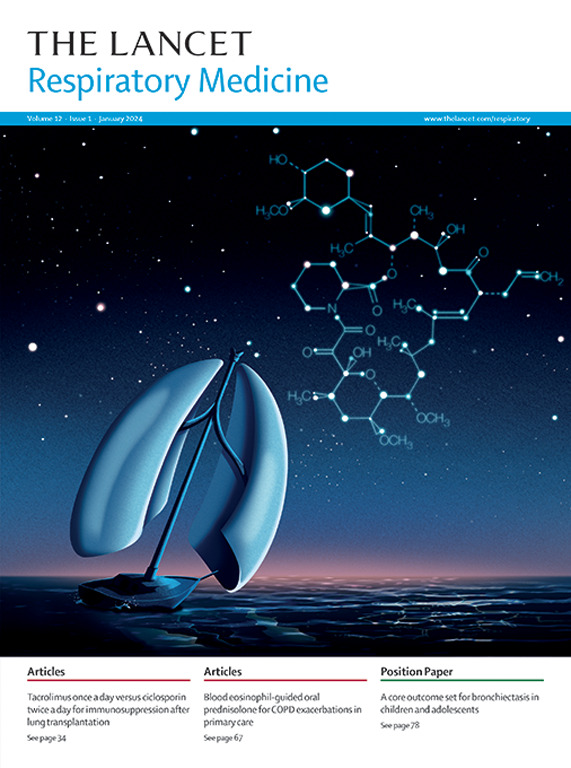In-hospital outcomes and 6-month follow-up results of patients supported with extracorporeal membrane oxygenation for COVID-19 from the second wave to the end of the pandemic (EuroECMO-COVID): a prospective, international, multicentre, observational study
IF 38.7
1区 医学
Q1 CRITICAL CARE MEDICINE
引用次数: 0
Abstract
Background
Extracorporeal membrane oxygenation (ECMO) for COVID-19 was thoroughly assessed during the first pandemic wave, but data on subsequent waves are limited. We aimed to investigate in-hospital and 6-month survival of patients with COVID-19 supported with ECMO from the second pandemic wave (Sept 15, 2020) until the end of the pandemic (March 21, 2023, announced by WHO).Methods
EuroECMO-COVID is a prospective, observational study including adults (aged ≥16 years) requiring ECMO respiratory support for COVID-19 from 98 centres in 21 countries. We compared patient characteristics and outcomes between in-hospital survivors and non-survivors. Mixed-effects multivariable logistic regressions were used to investigate factors linked to in-hospital mortality. 6-month survival and overall patient status were determined via patient contact or chart review. This study is registered with ClinicalTrials.gov, NCT04366921, and is complete.Findings
We included 3860 patients (2687 [69·7%] were male and 1169 [30·3%] were female; median age 51 years [SD 11]) from 98 centres in 21 countries. In-hospital mortality was 55·9% (n=2158), with 81·2% (n=1752) deaths occurring during ECMO support. More non-survivors had diabetes, hypertension, cardiovascular disease, and renal failure, and required more pre-ECMO inotropes and vasopressors compared with survivors. Median support duration was 18 days (IQR 10–31) for both groups. Factors linked to in-hospital mortality included older age, pre-ECMO renal failure, pre-ECMO vasopressors use, longer time from intubation to ECMO initiation, and complications, including neurological events, sepsis, bowel ischaemia, renal failure, and bleeding. Of the 1702 (44·1%) in-hospital survivors, 99·7% (n=1697) were alive at 6 months follow-up. Many patients at 6 months follow-up had dyspnoea (501 [32·0%] of 1568 patients), cardiac (122 [7·8%] of 1568 patients), or neurocognitive (168 [10·7%] of 1567 patients) symptoms.Interpretation
Our data for patients undergoing ECMO support for respiratory distress from the second COVID-19 wave onwards confirmed most findings from the first wave regarding patient characteristics and factors correlated to in-hospital mortality. Nevertheless, in-hospital mortality was higher than during the initial pandemic wave while 6-month post-discharge survival remained favourable (99·7%). Persisting post-discharge symptoms confirmed the need for post-ECMO patient follow-up programmes.Funding
None.求助全文
约1分钟内获得全文
求助全文
来源期刊

Lancet Respiratory Medicine
RESPIRATORY SYSTEM-RESPIRATORY SYSTEM
CiteScore
87.10
自引率
0.70%
发文量
572
期刊介绍:
The Lancet Respiratory Medicine is a renowned journal specializing in respiratory medicine and critical care. Our publication features original research that aims to advocate for change or shed light on clinical practices in the field. Additionally, we provide informative reviews on various topics related to respiratory medicine and critical care, ensuring a comprehensive coverage of the subject.
The journal covers a wide range of topics including but not limited to asthma, acute respiratory distress syndrome (ARDS), chronic obstructive pulmonary disease (COPD), tobacco control, intensive care medicine, lung cancer, cystic fibrosis, pneumonia, sarcoidosis, sepsis, mesothelioma, sleep medicine, thoracic and reconstructive surgery, tuberculosis, palliative medicine, influenza, pulmonary hypertension, pulmonary vascular disease, and respiratory infections. By encompassing such a broad spectrum of subjects, we strive to address the diverse needs and interests of our readership.
 求助内容:
求助内容: 应助结果提醒方式:
应助结果提醒方式:


